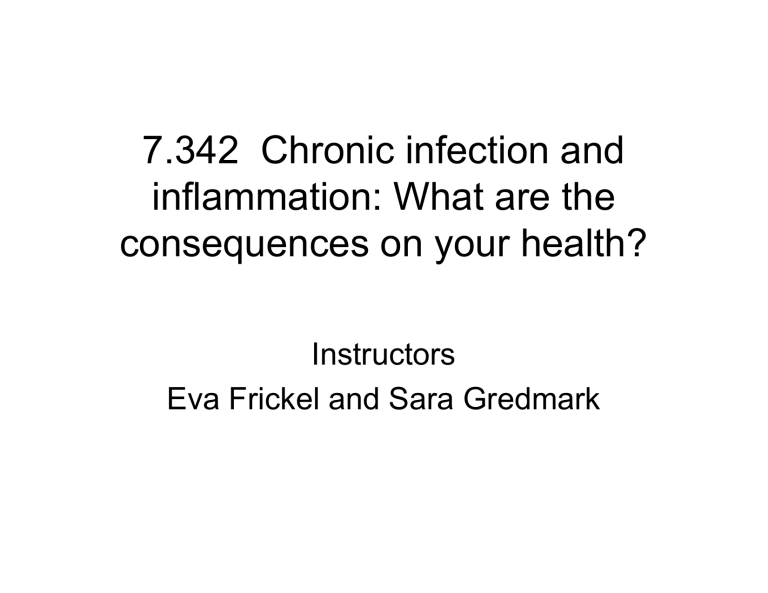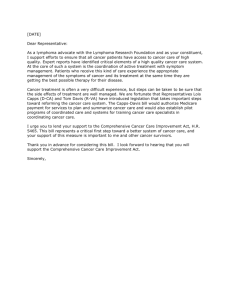7.342 Chronic infection and inflammation: What are the consequences on your health? Instructors

7.342 Chronic infection and inflammation: What are the consequences on your health?
Instructors
Eva Frickel and Sara Gredmark
How to read a scientific paper
Organization of a paper
- Title
- Authors and their affiliation
- Abstract
- Introduction
- Methods
- Results with tables and figures
- Discussion
- References
Reading a scientific paper
First look at...
- Title
- Abstract
- Figures and tables
- Introduction, results and discussion
- and Methods
Then...read the paper
- active, not passive reading
- use highlighter, underline, scribble comments or questions on it, make notes
- just because it’s published, doesn’t mean it’s right!
Evaluating a paper
• What questions does the paper address?
• What are the main conclusions of the paper?
• What evidence supports those conclusions?
• What is the quality of the evidence?
• Do the data actually support the conclusions?
• Why are the conclusions important?
What questions does the paper address?
• Descriptive research
– often in early stages of our understanding can't formulate hypotheses until we know what is there
• Comparative research
– Ask how general or specific a phenomenon is
• Analytical or hypothesis-driven research
– test hypotheses
• Methodological research
– Find out new and better ways of doing things
– Describe new resources
• Many papers combine some of the above
•
•
•
•
•
• What questions does the paper address?
What are the main conclusions of the paper?
What evidence supports those conclusions?
What is the quality of the evidence?
Do the data actually support the conclusions?
Why are the conclusions important?
What are the main conclusions?
• Look at Title, Abstract and Discussion
• What kind of conclusion?
– Of general relevance?
– Broad in scope?
•
•
•
•
•
•
What questions does the paper address?
What are the main conclusions of the paper?
What evidence supports those conclusions?
What is the quality of the evidence?
Do the data actually support the conclusions?
Why are the conclusions important?
What evidence supports them?
• Look at Results section and relevant tables and figures.
– Maybe only one primary experiment to support a point.
– More often several different experiments or approaches combine to support a particular conclusion.
– First experiment might have several possible interpretations, and the later ones are designed to distinguish among these.
• In the ideal case, the Discussion begins with a section of the form "Three lines of evidence provide support for the conclusion that...."
•
•
•
•
•
•
What questions does the paper address?
What are the main conclusions of the paper?
What evidence supports those conclusions?
What is the quality of the evidence?
Do the data actually support the conclusions?
Why are the conclusions important?
Judging the quality of the evidence
• You need to understand the methods thoroughly
– may need to consult textbooks
• You need to know the limits of the methods
• Separate fact from interpretation
• Are the results expected?
– Extraordinary claims require extraordinary evidence
• Look at details, assess them for plausibility
– The truthfulness of the whole depends on the quality of its parts!
• Where are the controls?
•
•
•
•
•
•
What questions does the paper address?
What are the main conclusions of the paper?
What evidence supports those conclusions?
What is the quality of the evidence?
Do the data actually support the conclusions?
Why are the conclusions important?
Do the data support the conclusions?
• Data may be believable, but not support the conclusion the authors wish to reach
– logical connection between the data and the interpretation is not sound (often hidden by bad writing)
– There might be other interpretations that are consistent with the data
• Rule of thumb
– If multiple approaches, multiple lines of evidence, from different directions, supporting the conclusions, then more credible.
• Question assumptions!
– Identify any implicit or hidden assumptions used by the authors in interpreting their data.
•
•
•
•
•
•
What questions does the paper address?
What are the main conclusions of the paper?
What evidence supports those conclusions?
What is the quality of the evidence?
Do the data actually support the conclusions?
Why are the conclusions important?
Why are the conclusions important?
What questions does the paper address?
What are the main conclusions of the paper?
What evidence supports those conclusions?
What is the quality of the evidence?
Do the data actually support the conclusions?
Why are the conclusions important?
Conclusion
Peer review: you are the judge!
Patient case study 1
• Man 25 years old comes to his GP due to fever, nightsweats and weight loss, he has also noticed swollen lymph nodes in the neck
• The man has had these symptoms for a few weeks
• Previously healthy
• The GP finds enlarged lymph nodes in the neck and above the collarbone
• X-ray of chest shows no spread of disease to internal organs
• Diagnosis based on biopsy shows Hodgkin's lymphoma
• Treatment with chemotherapy and radiation
Patient case study 2
• 70 years old man with diabetes and a slightly elevated blood pressures comes to his GP for a routine blood pressure control
• Standard blood tests shows low blood counts
• The GP notices swollen non-tender lymph nodes
• Diagnosis based on biopsy shows a low-grade non-
Hodgkin's lymphoma (NHL)
• Often the patient is not made very sick from a low-grade
(NHL) and a "wait and watch" approach with the disease was taken in this case.
• Important is to check frequently on the patient's physical exam, blood tests, scans, and sometimes bone marrow to remain alert to the need for treatment if the disease becomes more aggressive.
Typical symptoms of Hodgkin lymphoma
• painless swelling in the neck, armpits or groin
• night sweats
• unexplained fever
• unexplained weight loss
B-symptoms
• unexplained fatigue
• cough or difficulty in breathing
• persistent itch all over the body (pruritus)
Risk factors for Hodgkin's lymphoma
• Genetic
• Epstein-Barr virus (infectious mononucleosis)
• congenital and acquired immunodeficiency
(AIDS or post transplantation immunosuppression)
• Epstein Barr virus (EBV) is associated with around one-third of Hodgkin's lymphoma (HL) cases and this association is believed to be causal.
Diagnosis and treatment
• Diagnosis:
1. Thorough patient history and physical examination
2. Blood tests; number of cells and X-rays of chests
3. Final diagnosis microscopic examination of cells of the swollen lymph node (biopsy).
• Treatment: Upon complete diagnosis with staging of the lymphoma, treatment with chemotherapy and radiation











